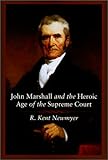As a devotee of legal history and former denizen of the alma mater and namesake law school of the title figure, I suppose it was no surprise that I found myself drawn to R. Kent Newmyer’s latest entry into the ranks of American judicial biography; John Marshall and the Heroic Age of the Supreme Court. Having enjoyed Newmyer’s biography of Justice Story, I’ll admit that I approached this new work with high expectations as well as a sense of trepidation. I feared that, in placing my hopes so high, I was setting myself up for disappointment. I am quite pleased to report that my worries were for naught. John Marshall and the Heroic Age of the Supreme Court is an exhaustively researched work that is both sophisticated and elegantly written.
Even though the author was able to draw upon a new scholarly edition of Marshall’s papers in his research, Marshall’s ‘paper trail’ was nevertheless somewhat sparse. Newmyer remarks in his introduction upon Marshall’s “slender corpus of personal papers”, and later observes that Marshall “showed little interest in preserving his papers for posterity — and even may have destroyed some of them.” However, in the absence of the ephemera and ‘grey literature’ that so often forms the stuff of biographical analysis, the author fell back on Marshall’s corpus of judicial opinions. Perhaps as a result of this, Newmyer paints a compelling and nuanced portrait of Marshall, not so much as a man (avoiding, by and large, discussion of Marshall’s family, social and private life), but as a thinker. Newmyer’s book revolves around the reasoning and concordant beliefs and goals of this public intellectual.
Though the book revolves around Marshall as a jurist, Newmyer traces the roots of Marshall’s thought back to his years as a young man in pre-revolutionary Virginia, through his decision to fight for independence, and his experiences as a lawyer and Federalist politician during the early years of the American republic. These experiences, Newmyer contends, incubated and defined Marshall’s ideas about the proper shape of the fledgling nation, and the role of the courts therein.
During his pre-court years, Marshall advocated for a strong federal government, which he believed was the best course toward self-preservation for a fledgling republic in a world of established imperial powers. Marshall’s view of the judiciary – a view that was novel at the time – was that of a neutral arbiter of constitutional disputes. This, he believed, would protect the nation from the pitfalls that he found inherent in the mixing of politics (both partisan and philosophical). Newmyer finds Marshall’s pre-court years so vital to his synthesis and analysis of Marshall’s work as a jurist that he devotes the first quarter of the book to this period in Marshall’s life.
During his time on the bench, Marshall made substantial progress toward furthering his vision for the new American law. Justice Oliver Wendell Holmes once observed of Marshall that, “part of his greatness consists of his being there” (a more eloquent take on Woody Allen’s quip that “ninety percent of life is just showing up’). In a sense, the fact that Marshall was in the right place at the right time allowed him the opportunity, during the formative years of the republic, to advance his views of American jurisprudence. He was not, by any measure, universally successful in his attempts to influence the nation; he found the advent of Jacksonian political ideals in particular to be a rebuke to his stated philosophies. However many of his views – novel as they may have seemed in his day – impressed themselves indelibly on the legal systems of the United States.
Perhaps because Marshall’s opinions in cases such Marbury v. Madison and McCulloch v. Maryland are so fundamental to American law, it is surprising to note, as Newmyer does, that Marshall’s reputation as a titan of jurisprudence is founded upon on surprisingly few judicial opinions. And though Newmyer discusses these and other well-known opinions, he also examines Marshall’s lesser-known opinions, such as Huidekoper’s Lessee v. Douglass, 4 US 392 (1805), and Providence Bank v. Billings 29 U.S. 514 (1830). In doing so, Newmyer is able to illustrate both the overriding tenets of Marshall’s vision, and his work toward a strong federal government. Newmyer’s account examines the evolution of Marshall’s constitutional beliefs, their nuances, and their evolution over time.
Though Newmyer does not seek to hold Marshall up as a mirror to our times, it is worth noting that the politico-legal tensions of Marshall’s times bear a striking resemblance to ours. Then as now, debates raged over state sovereignty, federalism, the proper role of the judiciary and Constitutional interpretation. Because of this resemblance, the timing of Newmyer’s work is particularly welcome and the lessons of the Marshall Court persist as pertinent and valuable.
Part of the Southern Biography Series at LSU Press, this book is of particular interest to libraries with collections that deal with legal history, the philosophy of law, federalism, states’ rights or American history. However, given the pivotal role played by John Marshall in the formation of American jurisprudence, this book could easily find a welcome home in any academic law library.

| John Marshall and the Heroic Age of the Supreme Court (Southern Biography Series) Author: R. Kent Newmyer Binding: Hardcover List price: $44.95 Amazon price: |

